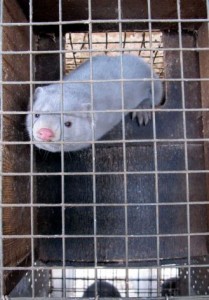By Meredith Metsker
Daily News staff writer

In this Feb. 12, 2013 file photo, a minks looks out from its cage at Bob Zimbal’s fur farm in Sheboygan Falls, Wis. The Sheboygan County Sheriff’s Office says the May 13, 2013 thefts of more than 300 baby mink from the Dittrich Mink Ranch in Mosel doesn’t look like the work of animal rights activists. Photo: Carrie Antlfinger
Washington State University research facilities have been targeted again in the fourth edition of The Final Nail, a document written by anonymous authors affiliated with the radical Animal Liberation Front animal rights group.
WSU’s Wild Ungulate Facility and the Small Mammal Research Facility at 3055 Antelope Trail in Pullman were listed on The Final Nail’s most-wanted hit list. The document stated ALF believed WSU, along with Idaho State University and Michigan State University, was conducting animal research benefitting the fur industry.
Steve Russell, director of WSU’s Office of the Campus Veterinarian, said the statement is untrue and that WSU has not conducted any animal-based research for the fur industry in many years. Russell and the Office of the Campus Veterinarian are responsible for making sure all animals used in research, testing and teaching at WSU are used properly and receive veterinary care.
“It’s a little bit disconcerting to have this highlighted in there,” Russell said. “They’ve got it entirely wrong.”
The 58-page document released Friday contains more than 100 addresses for suspected experimental fur farms in the United States. It also contains guidance on how to break into the farms, destroy breeding records and release animals without being caught.
Jerry Vlasak, ALF press officer, said he didn’t know who wrote The Final Nail guide but said the guides and past fur farm raids have been an effective tactic in closing down many farms.
In a report in The Final Nail, authors wrote that sheds on the east side of the Antelope Trail facility were thought to possibly contain captive mink. After taking photos from a nearby hill and conducting surveillance, the report’s author wrote the evidence suggested “a strong but inconclusive case for 3055 Antelope Trail as being the location of an experimental fur farm.”
Russell said the photos of the sheds in the report appeared to have been taken about three years ago. One of the sheds pictured was recently torn down.
Office break-in
Russell said former WSU researcher John Gorham, who died in 2011, once conducted a research program involving mink that was briefly funded by the fur industry, but the mink were not housed in the Antelope Trail facilities. Russell also said WSU no longer houses mink on campus.
ALF activists broke into Gorham’s office at WSU in 1991, destroyed his records with hydrochloric acid and released six mink, seven coyotes and 10 mice. Vandals also destroyed research equipment and caused thousands of dollars in damage at WSU’s Avian Health Laboratory in Puyallup in 1999.
One of the sheds in ALF’s report thought to house mink now houses nine pygmy and cottontail rabbits. Lisa Shipley, a professor of wildlife for WSU’s School of Environment, said she and other researchers use the rabbits to conduct noninvasive nutrition and foraging studies.
Shipley said the studies, funded by the National Science Foundation, help researchers understand what the rabbits like to eat and how they like to eat. Each rabbit has its own separate living space because rabbits can be aggressive toward each other.
“We’re trying to answer the question of how they make the decision of what to do,” Shipley said. “We can control it better in captivity. We’re relating back to what they do in the wild.”
Saving pygmy rabbits
>From 2001-10, the sheds on the Antelope Trail facility housed an endangered species of pygmy rabbit native to Washington. Shipley said that in 2001, there were only 16 of the rabbits left in the world.
WSU and two other zoos took the rabbits in and slowly rebuilt the population over the next 10 years before releasing them into a “soft release” site in 2010. The protected site allowed the rabbits to transition back into living in the wild while breeding. Baby rabbits born in the soft release site were released into the wild.
Shipley said the rabbits have done well so far in the wild, and the captive-breeding project appears to have been successful. The project was funded by the U.S. Fish and Wildlife Service and the Washington Department of Fish and Wildlife.
When the third edition of ALF’s Final Nail was released in 2008 and listed the same WSU facility on its hit list, Shipley said she was concerned for the safety of the endangered pygmy rabbits.
“My worry was that someone would target it and destroy all the last remaining pygmy rabbits from Washington,” Shipley said. “That was pretty scary.”
Russell said there are no heightened security measures in place following Friday’s release of the most recent Final Nail guide. The Antelope Trail facilities, which also house more than 25 deer for foraging studies, are guarded by security cameras, fences, lights and police.
Other than the existing protections, Shipley said security can’t be much higher at the facility.
“That makes it a little bit nerve-wracking, I have to say,” Shipley said.
Russell said all of WSU’s animal research facilities are potential targets for animal rights activist groups like ALF, but the Antelope Trail facility is listed in The Final Nail because of its alleged connection to the fur industry.
Shipley, who has worked at WSU for 16 years, said she is a wildlife biologist, and all of the studies she conducts benefit animals.
“I’m studying for their own good, not for human good,” she said.
The Antelope Trail facilities are a part of WSU’s Department of Natural Resource Sciences and the School of the Environment.
Meredith Metsker can be reached at (208) 883-4628, or by email to mmetsker@dnews.com.

